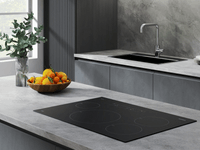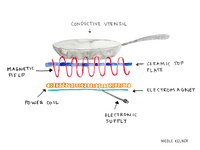Induction Cooktop and Stove Buyer’s Guide
By Mara Abbott

Table of contents
Induction cooking is simply better
How does an induction cooktop work?
Things to consider before switching to induction
Induction cooking is simply better
In the past, it was common knowledge amongst chefs that cooking with gas was better than electricity. Traditional electric stoves were slow to heat up, hard to control, and difficult to clean.
But that was the past.
Today the best way to cook is using an induction cooktop or stove (also commonly referred to as an induction range). Not only are induction stoves more environmentally friendly and energy efficient than gas stoves, but cooking with induction is just a better experience.
Just ask chef Jon Kung, who recently made a video touting the benefits of induction over gas cooking. Or ask Rachelle Boucher, a professional chef who made the switch to an induction stove.
In this guide we’ll look at the benefits of induction cooking vs. traditional electric and induction vs. gas cooking.
What is an induction cooktop?
An induction cooktop is a cooking appliance that uses electromagnetism to heat pots and pans as opposed to traditional electric resistance or gas. The result is a more energy efficient and healthier way of cooking.
Visually, it’s easy to mistake an induction stove for a smooth-topped electric model. Yet induction cooktops use an electromagnetic field, rather than a hot flame or coil, to heat your cookware directly, boiling water 25-50% faster than either electric or gas stoves and responding rapidly to temperature changes.
Induction stoves are fully electric, so when paired with a renewable power source, they allow you to cook emissions-free. Induction is available at a variety of price points on full ranges, standalone cooktops, or simple single-element hot plates.
How does an induction cooktop work?
Image credit: Nicole Kelner
Gas or traditional electric stoves cook through conduction, using an open flame or a heated resistance coil as an intermediary that transfers warmth to your pan. Induction is faster, more precise and more efficient because it tosses out the fiery middleman, using electromagnetism to heat the cookware itself.
Beneath each zone of a smooth ceramic-glass induction cooktop lies a coiled copper wire. When you turn on a burner, an alternating electric current darts back and forth through the coil, oscillating dozens of times a second to create a magnetic field. If that field hits a material that resists its flow – say, the base of your favorite cast-iron skillet – it induces swirling electric flows called eddy currents, which generate heat in the resistant metal.
If you lift the pan, breaking the molecular connection, heat will no longer be created. Each burner on an induction stove has a sensor that recognizes the metal’s temperature and adjusts accordingly.
That’s why induction cooktops only work with pots and pans made of ferromagnetic materials, like iron and steel. Such items can be identified by tossing magnets at your current cookware collection – if it sticks to the bottom, that’ll work on induction.
Dipping into the physics makes it easy to see why induction cooktops perform so well. Metal molecules heat and cool rapidly, allowing for quick temperature changes since warmth is generated only within the pot or pan itself.
Because it operates without an intermediary, cooking with induction is more efficient than with a traditional electric cooktop or natural gas and doesn’t emit the type of fugitive radiant heat that steams up the kitchen on a hot day.
To learn more about how induction cooktops and ranges work, check out this video by Adam Ragusea.
Benefits of induction cooking
Environmental benefits
In recent years it’s become clear that cooking with natural gas is harmful to the environment. But it’s not just the carbon dioxide emissions that climate scientists are worried about.
The “natural gas” that seeps out of your burners is primarily composed of methane – a gas that uncombusted has a global warming potential more than eighty times greater than that of carbon dioxide over the first 20 years after it is released.
According to the most recent report from an international group of the world’s leading climate scientists, reducing global methane emissions in the very near term is a critical step to avoiding the most catastrophic consequences of climate change.
Previously it was thought that gas stoves burned most of the methane in the fuel. But a recent study from Stanford discovered that’s not the case. Researchers learned that the methane that leaks from gas stoves every year is comparable to the carbon dioxide emissions from about 500,000 gasoline-powered cars.
That’s not the only place gas is leaking though. Studies of oil and gas extraction and distribution infrastructure show rampant methane leaks from wellhead to pipeline to municipal connection.
A 2021 study found that in Boston, local methane emissions are three times higher than would be expected based on usage-based inventories due to leaks and belches in pipelines, transmission, and even appliances themselves.
One of the best ways we can all prevent these methane emissions is to get rid of the natural gas in our homes. That means ditching gas stoves for electric cooktops and induction ranges.
When paired with a renewable energy source, induction cooking is an emissions-free way to cook. That’s important even if you don’t have solar panels on your house, because renewables are rapidly increasing as a share of U.S. energy generation, a strong trend that is expected to continue. The average lifespan of an induction range is 15 to 17 years, so as the grid cleans up, so will the climate impact of your stove, whereas emissions from a gas cooktop are locked in.
Health benefits
A natural gas range not only harms the environment, it compromises your family’s health.
When turn on a gas burner you are combusting a fossil fuel in an enclosed space, releasing carbon monoxide, which will kills in short order at high enough concentrations, formaldehyde, a known carcinogen, and nitrogen dioxide, which increases the risk of respiratory illness and has been linked to cardiovascular effects, poor birth outcomes, diabetes, and cancer.
Gas stoves create unhealthy levels of nitrogen dioxide
A screenshot from a recent Carbon Switch gas stove experiment.
Nitrogen dioxide is particularly harmful to children, due to their higher breathing rates and immature lungs. Growing up in a home with a gas stove increases a child’s risk of developing asthma by as much as 42%. And while a range hood can help eliminate particulate pollution associated with any type of cooking, at least one study found that hoods have minimal impacts on nitrogen dioxide levels.
Recently, Carbon Switch founder Michael Thomas deployed air quality monitors in his own home to see how bad it really is. The top-line takeaway? It’s long past time to look at alternatives to your gas range.
Safety
Swapping to an induction stove not only protects your family from gaseous pollutants, it reduces the risk of burns and kitchen fires. Because induction heats the pan directly, it’s much more difficult for a child, pet, or distracted chef to be burned by a flame or heated coil. While some heat will transfer back into the cooking surface, the glass-ceramic cooktop is a poor conductor of heat, and will not reach high temperatures.
You can also worry less about what’s near your range – it’s possible to boil water on an induction cooktop with a piece of paper between the pot and the cooking surface and not start a fire, and most induction stoves have safety sensors that turn off a burner altogether when a pan is removed or boils dry.
Better cooking experience, easier to clean
Beyond concerns of energy efficiency, health, or safety, induction stoves offer a superior cooking and cleaning experience.
Induction stoves will boil water more quickly than gas or electric, and can be precisely controlled with touch-screen panels or traditional knobs. Because the surface of the cooktop doesn’t heat, if your stew boils over, it won’t burn on to your stove, making it easy to clean.
Things to consider before switching to induction
Compatible cookware
Induction only works on ferromagnetic metals, so while your stainless steel and cast iron cookware will make a smooth transition, your copper tea kettle will not.
For pots and pans of unknown composition use the magnet test – if one sticks strongly to the bottom of a pot or pan, it’s induction approved. Glass, copper and aluminum pots and pans will not work unless they have an additional metal plate in the bottom.
Electrical requirements
An induction stove requires a dedicated 220-volt outlet protected by 40-50 amp breakers. If you are already using an electric stove, your current wiring is likely sufficient. If you are transitioning from gas, however, you may need to install high-capacity wiring, as most gas stoves require only a 120-volt circuit. You might also need to upgrade your electric panel with a two-pole circuit.
In all, this is typically a several-hour job for a licensed electrician, but the total time and ultimate cost of the project will depend on the distance from your circuit breaker to your new cooktop.
In a gas-to-electric conversion, you will also need to work with a plumber to properly cap your gas line and close its valve.
The question of knobs
Many induction ranges and cooktops feature a sleek touchscreen control panel in the place of the traditional knobs. However, many manufacturers are beginning to roll out induction stoves with knobs for customers that want a tactile adjustment experience or a more traditional look in their kitchen. This option is most often seen on the mid- to high-range models.
If you have a tough time imagining yourself using digital buttons or a smartphone to control your stir fry, it may be worth getting a model with knobs.
Induction cooktop vs. electric
Both induction and electric cooktops protect your family and the climate by eliminating methane emissions and most indoor air pollution. Induction ranges are more expensive to purchase initially, but their superior energy efficiency makes them cheaper to operate once installed.
Induction stoves offer faster cooking and more precise control, eliminate the risks of burns or fires, and make for quicker cleanup. A traditional electric cooktop, however, will allow you to continue to use your current pots and pan, whereas an induction stove may require you to retire or replace some pieces.
Reasons to buy an induction cooktop
- Rapid and responsive cooking performance
- Reduced risk of burns and cooking fires
- More energy-efficient
- Easier to clean
Reasons to buy an electric cooktop
- Less expensive upfront cost
- Works with all pots and pans
Induction vs. gas cooking
If you care about the environment and your family’s health, induction and traditional electric cooktops and ranges are better than gas.
The rise in popularity of gas stoves was actually fueled by a PR push from the natural gas industry itself. What gas companies don’t want you to know is that the beloved responsiveness of a gas burner can now be matched or beaten by today’s induction cooktops.
Induction cooktops are also free of the radiant heat that creates a sweaty kitchen, which means you will stay cooler on hot summer days in the kitchen.
As mentioned earlier, induction cooking is also safer than gas cooking since there’s no open flame or indoor gas combustion. That means less risk of burns or grease fires. It also means less indoor air pollution and risk of carbon monoxide poisoning.
Induction cooktops are also easier to clean since the plate doesn’t get very hot and grease doesn’t bake on to your stove as is the case with gas cooking.
But if you like to char vegetables or warm tortillas over the open flame on your gas range, that won’t be possible on an induction burner. You can achieve similar results with a hot griddle pan or a broiler, or purchase a portable butane burner that you can use for specific tasks.
Reasons to buy a gas cooktop
- Familiar cooking experience
- Ability to char food on a flame
- Usable during a power outage
- Works with all pots and pans.
Reasons to buy an induction cooktop
- Less risk of fire or carbon monoxide poisoning.
- Reduces harmful pollutants like nitrogen dioxide in your home
- Eliminates greenhouse gas emissions (if paired with renewable electricity)
- Rapid and precise cooking experience
- Easier to clean
How much does induction cost?
Recently we published an entire guide on induction stove costs and prices. Here’s the quick summary.
The majority of top-rated induction ranges slide in between $2,000 and $4,000. That said, well-reviewed budget models can be had for closer to $1,000 if you hit a sale on the right day. A standalone induction cooktop runs between $1,000 and $3,000.
If you’re switching from gas to induction cooking you may also need to pay an electrician to upgrade your electrical circuits, outlet, and panel. And you will probably need to pay a plumber to cap your gas line. The extent and cost of this work varies widely. For some it will cost a few hundred dollars and for others it may cost a few thousand.
Want to try induction, but want a low-commitment experience first? A good portable induction cooktop can be had for $75-$150. Once you’re hooked and get your cooktop or range ordered, you can pass the portable version—and your recommendation—on to a friend.
Read more stories about electrification and home energy-efficiency
If you want to learn more about the problems with gas cooking, check out these recent Carbon Switch stories:
Or if you want to read about other ways to cut your carbon footprint and save energy check out these recent guides:
- Heat Pump Water Heater Buyer’s Guide
- LED Lighting Buyer’s Guide
- Everything You Need to Know Before Buying a Heat Pump
And stay tuned for our next story featuring reviews of the best induction cooktops and ranges. If you want us to let you know when that story goes live, sign up for the Carbon Switch newsletter.





